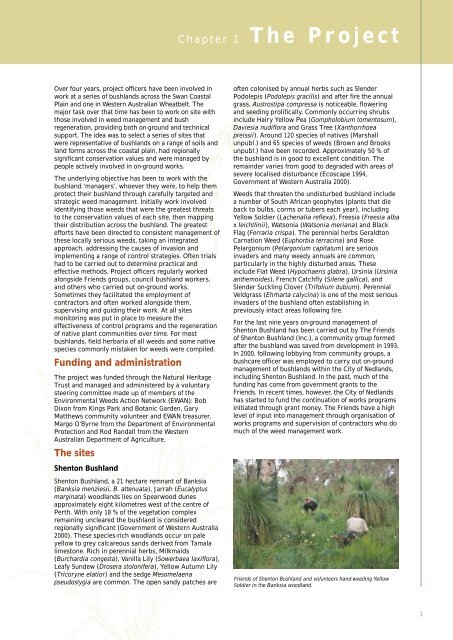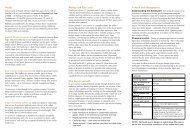Bushland Weeds Manual - Environmental Weeds Action Network
Bushland Weeds Manual - Environmental Weeds Action Network
Bushland Weeds Manual - Environmental Weeds Action Network
You also want an ePaper? Increase the reach of your titles
YUMPU automatically turns print PDFs into web optimized ePapers that Google loves.
Over four years, project officers have been involved in<br />
work at a series of bushlands across the Swan Coastal<br />
Plain and one in Western Australian Wheatbelt. The<br />
major task over that time has been to work on site with<br />
those involved in weed management and bush<br />
regeneration, providing both on-ground and technical<br />
support. The idea was to select a series of sites that<br />
were representative of bushlands on a range of soils and<br />
land forms across the coastal plain, had regionally<br />
significant conservation values and were managed by<br />
people actively involved in on-ground works.<br />
The underlying objective has been to work with the<br />
bushland ‘managers’, whoever they were, to help them<br />
protect their bushland through carefully targeted and<br />
strategic weed management. Initially work involved<br />
identifying those weeds that were the greatest threats<br />
to the conservation values of each site, then mapping<br />
their distribution across the bushland. The greatest<br />
efforts have been directed to consistent management of<br />
these locally serious weeds, taking an integrated<br />
approach, addressing the causes of invasion and<br />
implementing a range of control strategies. Often trials<br />
had to be carried out to determine practical and<br />
effective methods. Project officers regularly worked<br />
alongside Friends groups, council bushland workers,<br />
and others who carried out on-ground works.<br />
Sometimes they facilitated the employment of<br />
contractors and often worked alongside them,<br />
supervising and guiding their work. At all sites<br />
monitoring was put in place to measure the<br />
effectiveness of control programs and the regeneration<br />
of native plant communities over time. For most<br />
bushlands, field herbaria of all weeds and some native<br />
species commonly mistaken for weeds were compiled.<br />
Funding and administration<br />
The project was funded through the Natural Heritage<br />
Trust and managed and administered by a voluntary<br />
steering committee made up of members of the<br />
<strong>Environmental</strong> <strong>Weeds</strong> <strong>Action</strong> <strong>Network</strong> (EWAN): Bob<br />
Dixon from Kings Park and Botanic Garden, Gary<br />
Matthews community volunteer and EWAN treasurer,<br />
Margo O’Byrne from the Department of <strong>Environmental</strong><br />
Protection and Rod Randall from the Western<br />
Australian Department of Agriculture.<br />
The sites<br />
Shenton <strong>Bushland</strong><br />
Shenton <strong>Bushland</strong>, a 21 hectare remnant of Banksia<br />
(Banksia menziesii, B. attenuata), Jarrah (Eucalyptus<br />
marginata) woodlands lies on Spearwood dunes<br />
approximately eight kilometres west of the centre of<br />
Perth. With only 18 % of the vegetation complex<br />
remaining uncleared the bushland is considered<br />
regionally significant (Government of Western Australia<br />
2000). These species-rich woodlands occur on pale<br />
yellow to grey calcareous sands derived from Tamala<br />
limestone. Rich in perennial herbs, Milkmaids<br />
(Burchardia congesta), Vanilla Lily (Sowerbaea laxiflora),<br />
Leafy Sundew (Drosera stolonifera), Yellow Autumn Lily<br />
(Tricoryne elatior) and the sedge Mesomelaena<br />
pseudostygia are common. The open sandy patches are<br />
Chapter 1 The Project<br />
often colonised by annual herbs such as Slender<br />
Podolepis (Podolepis gracilis) and after fire the annual<br />
grass, Austrostipa compressa is noticeable, flowering<br />
and seeding prolifically. Commonly occurring shrubs<br />
include Hairy Yellow Pea (Gompholobium tomentosum),<br />
Daviesia nudiflora and Grass Tree (Xanthorrhoea<br />
preissii). Around 120 species of natives (Marshall<br />
unpubl.) and 65 species of weeds (Brown and Brooks<br />
unpubl.) have been recorded. Approximately 50 % of<br />
the bushland is in good to excellent condition. The<br />
remainder varies from good to degraded with areas of<br />
severe localised disturbance (Ecoscape 1994,<br />
Government of Western Australia 2000).<br />
<strong>Weeds</strong> that threaten the undisturbed bushland include<br />
a number of South African geophytes (plants that die<br />
back to bulbs, corms or tubers each year), including<br />
Yellow Soldier (Lachenalia reflexa), Freesia (Freesia alba<br />
x leichtlinii), Watsonia (Watsonia meriana) and Black<br />
Flag (Ferraria crispa). The perennial herbs Geraldton<br />
Carnation Weed (Euphorbia terracina) and Rose<br />
Pelargonium (Pelargonium capitatum) are serious<br />
invaders and many weedy annuals are common,<br />
particularly in the highly disturbed areas. These<br />
include Flat Weed (Hypochaeris glabra), Ursinia (Ursinia<br />
anthemoides), French Catchfly (Silene gallica), and<br />
Slender Suckling Clover (Trifolium dubium). Perennial<br />
Veldgrass (Ehrharta calycina) is one of the most serious<br />
invaders of the bushland often establishing in<br />
previously intact areas following fire.<br />
For the last nine years on-ground management of<br />
Shenton <strong>Bushland</strong> has been carried out by The Friends<br />
of Shenton <strong>Bushland</strong> (Inc.), a community group formed<br />
after the bushland was saved from development in 1993.<br />
In 2000, following lobbying from community groups, a<br />
bushcare officer was employed to carry out on-ground<br />
management of bushlands within the City of Nedlands,<br />
including Shenton <strong>Bushland</strong>. In the past, much of the<br />
funding has come from government grants to the<br />
Friends. In recent times, however, the City of Nedlands<br />
has started to fund the continuation of works programs<br />
initiated through grant money. The Friends have a high<br />
level of input into management through organisation of<br />
works programs and supervision of contractors who do<br />
much of the weed management work.<br />
Friends of Shenton <strong>Bushland</strong> and volunteers hand-weeding Yellow<br />
Soldier in the Banksia woodland.<br />
1



